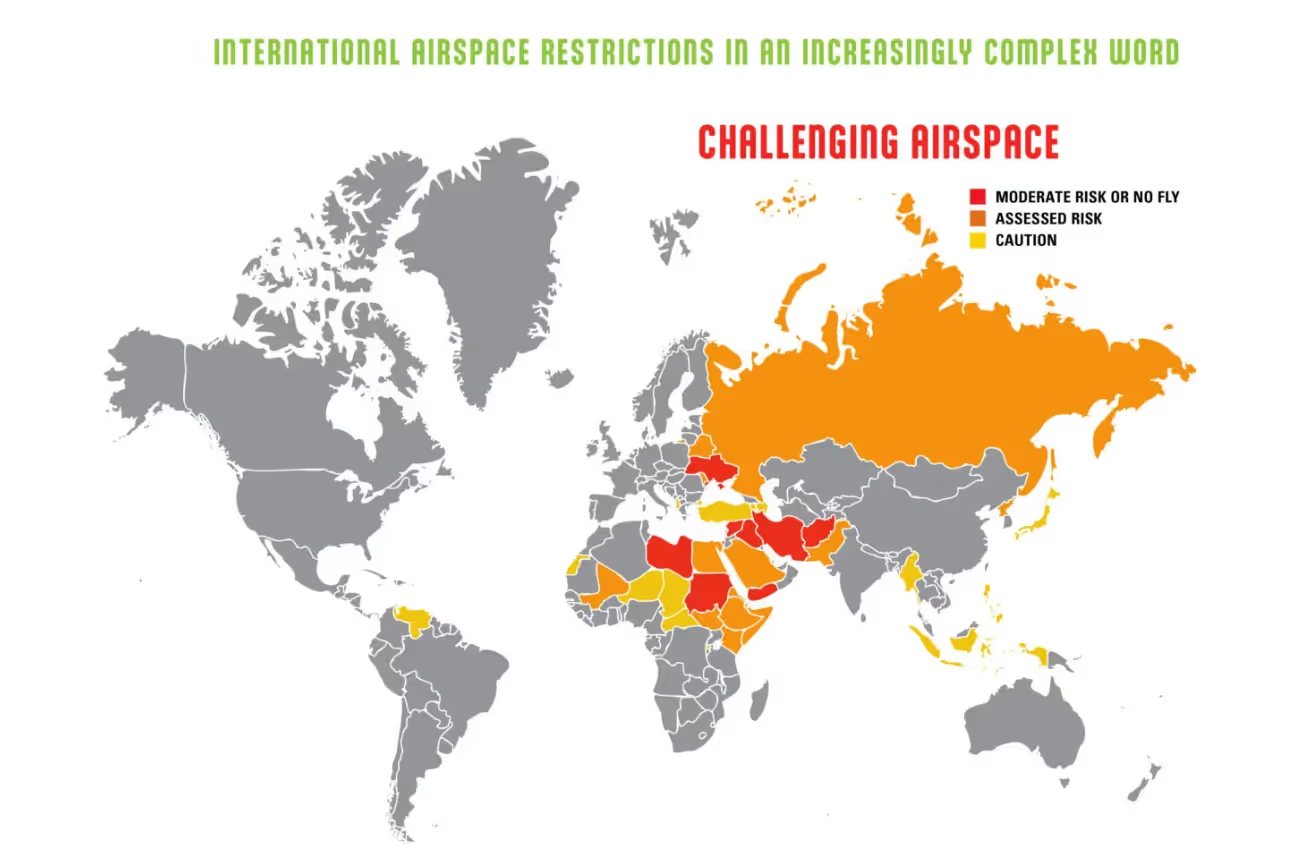The challenges of international trip planning in business aviation

In business aviation—especially in international mission planning—change often comes without much warning. An airspace can close just hours before departure due to geopolitical conflict, or new processes may suddenly require compliance before your operation is cleared to enter a specific region.
In my role as Vice President of Business Aviation at ForeFlight, my team’s guiding focus is to equip organizations with the tools and resources they need to navigate these challenges, foster safer flights for crews and passengers, and streamline workflows for more efficient operations.
This is the first in a series of blogs, where I’ll be sharing my thoughts on the complexities of international mission planning and offering solutions to navigate them.
Regulatory Hurdles and Global Compliance
Regulations are integral to every industry, and for good reason—they help ensure that businesses operate safely, protect our planet, and align with public interest. However, they can be challenging to navigate, especially when they’re constantly changing, often without much notice. In business aviation, regulatory changes are rapidly evolving, driven by both national and international policies aimed at minimizing environmental impact.
A relatively new regulation specific to the business aviation industry is the requirement for a Safety Management System (SMS). While SMS has been mandated in airlines since 2015, the FAA now requires charter, commuter, and air tour operators to implement an SMS by May 28, 2027. Notably, smaller, single-person operations are exempt from certain provisions in Part 5 that assume a multi-person operation.
Other regulations, like the Carbon Offsetting and Reducing Scheme for International Aviation (CORSIA) and RefuelEU, add more complexity. For smaller operators who don’t frequently fly to Europe, these stricter reporting and emission guidelines can pose a significant burden and could impact operations.
Keeping up with the constant regulation changes in different countries is nearly a full-time job. Many organizations turn to trip planning services with region-specific experts to stay up-to-date on the latest requirements.
Documentation and Permissions
The success of an international flight—and the satisfaction and safety of your pilots and passengers—starts with thorough planning. Whether you’re managing flights in-house or using a third-party provider, the responsibility ultimately remains with the operator, and there are a few key considerations when flying internationally.
Documentation
For domestic travel, documentation is fairly straightforward, typically limited to identification for passengers and pilots, along with a valid flight plan. International travel, however, introduces additional requirements—overflight permits, parking arrangements, valid passports, customs forms, proper aircraft documentation, validated flight plans, and more.
The workload for international flights is significantly higher, and your operation—big or small—can be stretched to the limit if it’s not fully prepared to handle these additional planning demands. Passengers will also need more documentation, and if they’re unfamiliar with international travel requirements, it’s your responsibility to inform them about what’s needed.
Security and Safety
One aspect often overlooked is managing security overseas. For high-profile clients, it’s common for them to have their own security team. However, if you’re flying clients such as families or individuals with lower profiles, security should still be carefully considered in your planning. Corruption in certain regions isn’t uncommon, so it’s important to have trusted local connections or security teams in place.
Beyond passenger and crew safety, aircraft security should be prioritized. Use reputable FBOs and handlers that have their own security measures in place, or hire a security team to watch over the aircraft while crew and passengers are away.
As modern cockpits rely on GPS technology for navigation, international flights may encounter satellite interference due to geopolitical conflicts. There are two types of GPS interference:
- GPS jamming: An intentional signal block that prevents pilots from following procedures or routes requiring precision.
- GPS spoofing: A scenario where an aircraft receives misleading GPS signals, potentially causing it to follow unauthorized routes.
While critical navigation systems have redundancies to mitigate GPS interference risks, other systems, such as the ground proximity warning system (GPWS), could still be affected.
Permissions
Overflight permits and landing permissions must also be planned in advance, as each country has unique and frequently changing requirements. These need to be accounted for on every international trip. For in-house trip planning, there are great resources online with up-to-date information on countries and their permit requirements. If you use a service like ForeFlight Trip Support, your regional-specific expert will manage these permissions throughout the planning process.
Airspace and Route Management Challenges
Restricted Airspace
Geopolitical conflicts, natural disasters, and terrorism events can suddenly affect your crews’ ability to enter their destination country. These disruptions can occur at any time, anywhere, making it critical to have alternate plans for last-minute changes. For example, unsafe airspace over Israel, Gaza, Ukraine, Russia, and Iran means rerouting traffic around these areas, leading to congestion in nearby airspace. And these are only the most common airspace restrictions. According to The Geneva Academy, over 45 armed conflicts worldwide create significant risks to air traffic.

Apart from navigating airspace over geopolitical hotspots, pilots and flight planners must also navigate around thousands of restricted areas worldwide. The United States alone hosts over 370 restricted areas across states and coastal regions. Every country has its own unique airspace restrictions, so awareness of these limitations is essential when planning international flights.
Route Management
According to the National Business Aviation Association (NBAA), a study of North Atlantic Track (NAT) errors revealed that business aviation accounts for 12 percent of errors and deviations in the NAT—despite making up only five percent of the traffic along this route. The study found that temperature fluctuations were affecting aircraft performance in unexpected ways. Using a flight planning tool that can accurately predict weather changes and suggest efficient alternate routes in real-time is crucial to maintaining a seamless operation for crews and passengers.
How ForeFlight Helps Navigate International Flight Planning Challenges
International flights can be exciting for both crew members and passengers, but in an industry that relies heavily on strict regulations and safety standards, it’s important to meticulously plan each to ensure success. While unexpected challenges are inevitable, dedicating time upfront to effective planning can significantly reduce their impact on your operation.
Expanding into international flights or serving new destinations can be a gradual process due to the numerous requirements and challenges involved. Although handling everything in-house is possible, for operations looking to grow beyond their current footprint, leveraging a flight planning tool and trip service provider can have a lasting positive impact on your operation.
ForeFlight, along with our integrated suite of products like Trip Support and Dispatch, is tailored to meet the specific needs of your operation and the destinations you plan. Trip Support helps tackle the complicated planning process with region-specific experts who are knowledgeable about the destinations you fly. With 24/7, 365-day service, Trip Support is available to support your operations as much or as little as you need.
Learn more about ForeFlight Trip Support and discover if it’s right for your operation.
Looking ahead: My next blog will cover insights on navigating the North Atlantic Tracks (NAT) and things you may not have considered during the planning process.






